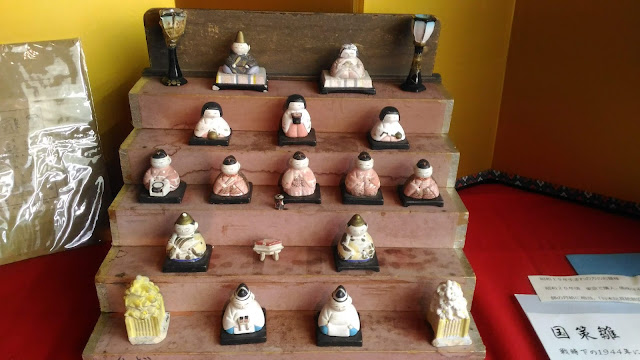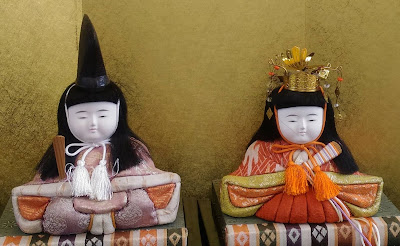Hinamatsuri–How to Celebrate Girls’ Day
March, “Sanngatsu”, 3月 is also known Yayoi. It’s the month when the bare branches of trees begin to bud, and the hard packed earth suddenly becomes covered with a soft layer of green grass (“kusa ki yaou zuki” 草木屋弥生月). The seasonal foods in Japan during March are “fuki” ふき (giant butterbur) “na no hana” 菜の花 (mustard blossoms), and “udo” うど (or Japanese spikenard). Rich in vitamins and minerals and all slightly bitter, these plants are good for detoxing and for fortifying the immune system.
Where Did Hinamatsuri Come From?
Japan’s “Girls’ Day” or “Dolls’ Festival” likely originated from a Chinese festival, but became a uniquely Japanese celebration over the years. The first historical record of Hinamatsuri can be found In Japan’s oldest novel, Genji Monogatari. According to the novel, March 3 is a good day for ritual cleansing, which is done by transferring a person’s trouble or illness to a person-shaped object (“hitogata” 人形) and throwing it in the river of the sea. The name “Hinamatsuri” comes from “hiina asobi” ひいな遊び, a game of dolls played by aristocratic children. March 3 was officially named “Hinamatsuri” in 1687.
How Do You Celebrate Hinamatsuri?
Traditionally, when a baby girl is born or for her first birthday, her parents or grandparents buy her a set of "Hinaningyo" 雛人形, or they are passed down in the family. The lavishly-dressed dolls represent an imperial court of the Heian Period. They are usually displayed on a five to seven-stepped platform called “hinadan.”
Fun Fact: Empress Meisho was the first person in Japanese history known to have played with hina dolls. Her father abdicated the throne, making her one of Japan’s eight female emperors at the age of 5.
Together, the hina dolls and various accessories are called “hinakazari. Each are displayed on their own designated step.
Top Step
“Dairisama” 代理様 and “ohinasama” お雛様 the imperial couple
“Bonbori” ぼんぼり lanterns
Second Step
“Sannin kanjo” 三人官女–the three ladies in waiting
Third Step
“Gonin bayashi” 五人囃子–the five musicians
Fourth Step
“Daijin” 大臣–the two ministers (one young, one old)
Fifth Step
“Shichou” 仕丁–the three servants
Sakura and tachibana citrus branches
Sixth Step
Chest, scissors box, dresser, sewing box, clothes bag, hibachi brazier, tea set
Seventh Step
Palanquin, lacquered "jubako", ox-drawn carriage
Because a complete set takes up a lot of space and costs thousands of dollars, not all families have them. Some people prefer “shinno kazari,” a small hina doll set which features only the “dairibina,” or imperial couple. Whether with two dolls or two thousand dolls, what’s important is to make the day a little special for the girls!
When To Display Your Hina Dolls
In general, Hina dolls are displayed from Risshun 立春 (the first day of spring according to the old Japanese lunisolar calendar) until March 4. In 2021, the first day of spring was February 3.
According to superstition, if you are slow in putting the dolls away, your daughter will have trouble getting married.
What Flowers To Display For Hinamatsuri
Earlier we mentioned that Hinmatsuri comes from a ritual cleansing, in which dolls carrying people's bad fortune are sent away on the water. This ritual continues today in the form of "Nagashi Bina" 流し雛, where paper dolls are placed together with peach, camellia and mustard blossoms in a little straw boat and floated them downstream.
Try It! Even if you don't have hina dolls, you can still brighten your room with seasonal flowers. Besides the three mentioned above, you could use daffodils, tulips, hyacinths, or your favorite springtime blooms.
What to Eat For Hinamatsuri
Hishimochi 菱餅
Hishimochi is three or five-tiered diamond-shaped mochi (rice cake) that represents fertility. The colors from the top down are pink (representing life), white (representing snow), and green (representing spring buds).
Try It! If you can’t get your hands on colored mochi, that’s ok! Try topping these Easy Pudding Cups with fresh strawberries (for pink), bananas (for white), and kiwi or green grapes.
Hina arare ひなあられ
Hina arare are colorful rice crackers that are either sweet and shaped like grains of rice or salty and round.
Try It! Tri-colored rice crackers might be hard to find, but rice crispy treats will make a nice substitute. They are easy to make from scratch, even for kids! For a more colorful version, use Fruit Loops instead of Rice Krispies.
Ushiojiru 潮汁
Ushiojiru is a very plain and simple dash soup with mitsbua leaf and clam. Since the top and bottom shells fit each other perfectly and no two clams are alike, these shellfish represent the perfect match that parents hope their daughters will make.
Try It! Here is a recipe for ushiojiru by JapaneseCooking101. The unique flavor of ushiojiru may not be universally appealing–how about instead serving a more familiar soup like: pea soup, cauliflower soup, or clam chowder?
Shirozake 白酒
Sweet white sake, originally peach blossom sake, is a Hinamatsuri special. For the younger partakers, substitute non-alcoholic amazake or their favorite fruit juice.
Chirashizushi ちらし寿司
"Scattered sushi" is the yummy wild card of sushi that has everything on it! Basically, vinegar-flavored sushi rice is topped with all the lucky ingredients of New Year's, such as shrimp, sweetened egg omelette cut into strips, lotus root, and fish roe. Chirashizushi is prefect for Hinamatsuri because it’s colorful and easy to make in large portions.
Try It! Here is Just One Cookbook’s easy chirashi zushi recipe (if you don’t have the mix, here’s how to make sushi rice. Color is the important thing for your Hinamatsuri lunch or dinner, so feel free to swap out ingredients. Alternatively, try your hand at Okinawan taco rice (or Mexican tacos!) for a fun twist. Or, if you don't have time to make a full-on Hinamatsuri meal, try a side dish of sautéed canadian bacon, sweet corn, and spinach, or a fresh salad of imitation crab, cucumber, and hard-boiled egg.









More stuff I never knew! I never knew you were supposed to take out the dolls on Risshun! I usually remember them just in time (when I display the Welsh flag on March 1, St. David's Day) ehehe. Taco rice is a capital idea! I want to do it.
ReplyDeleteWhaaaaa as usual your post is so thorough! I even had to supplement my notes from my school with your teaching! It's almost as if the teacher of my school copied off your blog, hahaha! You're too amazing. I'm so surprised about the people giving their bad luck to the dolls and sending them away. Does it sound like a certain scapegoat? Also I didn't know you can get the dolls out on Risshun either. That's nice, since it seems like a waste the display them for just a day or two. However I still can't get an answer to my main question... what about people like us who have no children? Are we still supposed to put out dolls? Or even celebrate this day?
ReplyDeleteI'll see if I can make some of these foods tomorrow!
Oops, I was getting an answer at that very second from the teacher! She says that you can celebrate even if you don't have children, and put dolls or not put dolls (this seems like a very kiraku festival!)
Delete